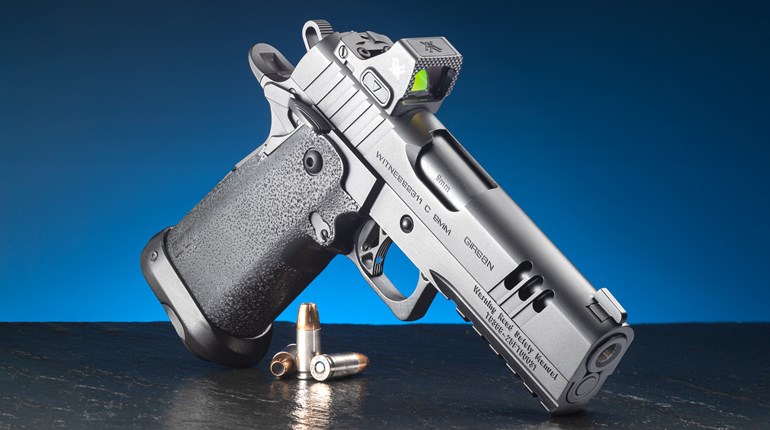
Remington has been in the firearm business for a very long time. The company has a history of manufacturing excellent guns of many different configurations and calibers. This history includes a celebrated run of 1911 pistols, about 28,000, manufactured during World War I. These pistols are now some of the most sought-after 1911s by collectors.
After the war, Remington discontinued the manufacture of the 1911, much to the chagrin of many enthusiasts. The company waited quite a few years before deciding to jump back on the 1911 bandwagon. A few years back, Remington developed the R1, which was a flat out, no-nonsense 1911 pistol in the early, original style. I had the chance to review the original R1 and found it to be quite the handgun, though it was nothing fancy, which was just fine.
The R1 gained popularity with handgunners quickly, and before long the company started offering several variations of the handgun, updated and much fancier than the original R1 pistol.
Remington recently introduced a double-stack 1911, and I was fortunate enough to get my hands on one. My test gun is called the R1 Tactical Double Stack, and is quite a piece of work. I’m not exactly a stranger to the double-stack 1911. Years ago, I received a test sample of the Para Ordnance double-stack 1911. Para was absorbed by Remington’s expansive operation. That Para Ordnance double stack was intriguing, but I found it to be a little uncomfortable in my hands. Not that I have small hands, but I much prefer a thinner grip on my handguns. Regardless, the idea of a 1911 holding 16 rounds of .45 ACP has always been intriguing.

Upon receiving the R1 Tactical Double Stack, I figured I would have the same experience with the grip as I had with the Para, but that wasn’t the case. It seemed to feel much better in my hands than the Para Ordnance. The R1’s grip panels are thin, giving the pistol a much more comfortable feel. In handling the gun, one would not tend to believe it holds a full 15 rounds in the magazine, plus one in the chamber, giving it twice the firepower of a standard 1911. But, the pistol is hefty—you know you’re holding a brute of a handgun.
In looking over the R1 Tactical, it’s apparent that Remington has gone to some trouble to fit it with special features. The G10 scales from VZ Grips are both machine-checkered and grooved, making purchase on the pistol solid as granite, plus providing a unique style that is appealing to the eye. The gun features jet-black Ionbond physical vapor deposition (PVD) coating, one of the best coatings out there. This finish is extremely durable and should survive years of use.
When looking over any handgun, one of the first things I generally notice are the sights. I’m pretty particular about sights, and I have a strong dislike for the modern, three-white-dot jobs for various reasons. While my test R1’s sights technically could be labeled three-dot, they far exceed the painted, three-dot systems I find objectionable. The rear sight on the test gun is a combat-style fixed sight with two small dots which are night sights. The front of the sight is cut, allowing an emergency, one-hand working of the slide. The front sight is a Trijicon unit with the big, tritium-dot night sight. I have generally stayed away from those large-dot front sights, but my aging eyes have taken a liking to them.

The R1 Tactical is fitted with a 5-inch, match-grade, stainless-steel barrel and bushing. The pistol also has a full-length guide rod and comes with a tool that assists breaking down the gun. The trigger is also match-grade, of the three-hole variety and adjustable. Using an RCBS trigger-pull scale to measure the trigger weight, I consistently came up with 4.75 pounds—not bad for an out-of-the-box pistol. The trigger pull is smooth and relatively crisp, with little creep.
The R1 Tactical features an ambidextrous safety—not my favorite, but I’m well aware than many shooters prefer this style. The grip safety is of the beavertail design. The flat mainspring housing is finely checkered, as is the front of the frame. Forward of the trigger guard, the bottom of the frame is milled and set up for whatever tactical components the shooter might want to utilize.

My test pistol did not arrive with the detachable magazine well, though they are readily available from Remington. The pistol came with two 15-round magazines.
I grabbed up a batch of Black Hills 230-grain ball ammunition and stepped out back to my little desert shooting range with the R1 Tactical, champing at the bit to give it a go. The R1’s magazines are equipped with bumper pads and proved to be easy to load, even the last couple of rounds. I started shooting at steel plates at about 25 yards, offhand. I must admit that the thick grip of the double stack took me a bit to get used to. As stated, I generally prefer a thin grip on any handgun. After a half-dozen rounds, I experienced a failure to feed. After clearing it, I adjusted my grip on the pistol and kept firing. I believe the failure to feed was my fault in not gripping the pistol quite properly. While touching off a couple more magazines of ammo, I experienced no more malfunctions whatsoever.

After firing a few boxes of the Black Hills through the R1 to familiarize myself with it, I set up my benchrest outfit for some more precise shooting. Using a sandbag rest from the bench, I set my paper target at 25 yards. I chose three different factory loads for the accuracy testing: Black Hills 230-grain FMJ, Hornady 185-grain FTX Critical Defense and Aeris 185-grain HP solid-copper ammunition.
Weather in southern New Mexico can frequently be uncooperative, as it was on my range day with the R1. Unfortunately, I was fighting a 20-mph crosswind, which didn’t do much to improve my bench shooting. I started with the Hornady stuff and fired a series of five-shot groups. Even with the windy conditions, the 185-grain FTX pills printed a decent set of groups, averaging 3 inches. My PACT chronograph measured this load at 991 fps.
Next was the Black Hills 230-grain FMJs. I’ve been shooting Black Hills ammo for many years, and have fired many thousands of rounds of this same load through a multitude of .45 ACP-chambered pistols, and have always had outstanding results. It was different with the R1, and again, my groups averaged 3 inches and 799 fps.
My third choice was the Aeris 185-grain HP solid-copper ammo. I have limited experience with Aeris, but I liked the results I achieved with the R1. The 185-grain solid copper is coated, which reduces barrel fouling and improves lubricity. The solid-copper bullet results in high weight retention, particularly through solid obstacles. The cases are nickel and the cartridge tolerances are quite high. I had good luck with the load through the R1, and wound up with a group average of 2.75 inches, with the average velocity being 1,030 fps.

Had the weather conditions been more acceptable, the R1 could well have shot tighter groups, however, the results I did get are quite satisfactory, in my opinion.
The R1 Tactical Double Stack pistol is quite an impressive firearm, overall. As a personal-defense handgun, it’s an outstanding choice. Having 16 rounds of .45 ACP is certainly nothing to take lightly. Speaking of which, that would be one of the few criticisms I have about the gun—the weight. Fully loaded, it’s a handful and probably not a pistol one would want to pack in a holster for extended periods of time. The thick, double-stack grip takes some getting used to, but I took to it fairly quickly.
Remington offers several variations of the R1 Double Stack, and I’m sure any fan of the 1911 wanting to have excellent ammunition capacity will find one that’s perfectly suited to their needs.







































